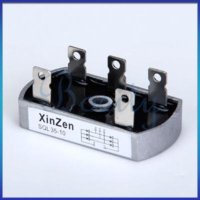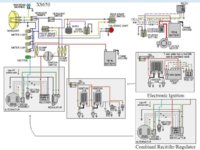I'm working with a 1973 tx650 motor that has points, ATU, battery, I am not charging the battery when riding around or when reving above 3k. The bike has just an early style 5 wire regulator with no tci. The bike is a kick start only and starts on first or second kick no problem. It even will idle no problem.
Following gggGarys thread here is what I found out. All readings were taken today with perfect 65 degree weather with a fluke 87 multimeter.
1. Battery is 12.5 v
2. Slap test does work but it is a very weak pull.
3. Jumper the green wire from the regulator and I DO NOT get 14.5 volts or anything close. Only 12.6 volts at best.
4. I have 12.4/12.3 on the brown wire at my ignition switch, and then the same at the positive brush terminal which is the black wire as mentioned in the trouble shooting guide.
5. Measuring the rotor resistance I get 5 ohms. Nothing when measuring rings to ground.
6. I'm unable to get this reading at the moment mostly because of the weather pack connector I have on the bike and the time here is 9 pm do the neighbors would be quite pissed at all the noise. I WILL TRY and get this tomorrow.
7. I get exactly .5 ohms on all three phases.
I'm unsure of the yellow write that should be capped off when running a solid state system but I will look into that now. The previous owner was the one who wired the bike this way and it seems that everything is correct. I DO HAVE the 3 plastic screw's on the brushes for a solid state regulated system.
I've been planning on a pma & pamco but wanted to ride the bike a little bit as I just got plate for it.
Anyone got any ideas? I'm open all suggestions!!! Thanks
Following gggGarys thread here is what I found out. All readings were taken today with perfect 65 degree weather with a fluke 87 multimeter.
1. Battery is 12.5 v
2. Slap test does work but it is a very weak pull.
3. Jumper the green wire from the regulator and I DO NOT get 14.5 volts or anything close. Only 12.6 volts at best.
4. I have 12.4/12.3 on the brown wire at my ignition switch, and then the same at the positive brush terminal which is the black wire as mentioned in the trouble shooting guide.
5. Measuring the rotor resistance I get 5 ohms. Nothing when measuring rings to ground.
6. I'm unable to get this reading at the moment mostly because of the weather pack connector I have on the bike and the time here is 9 pm do the neighbors would be quite pissed at all the noise. I WILL TRY and get this tomorrow.
7. I get exactly .5 ohms on all three phases.
I'm unsure of the yellow write that should be capped off when running a solid state system but I will look into that now. The previous owner was the one who wired the bike this way and it seems that everything is correct. I DO HAVE the 3 plastic screw's on the brushes for a solid state regulated system.
I've been planning on a pma & pamco but wanted to ride the bike a little bit as I just got plate for it.
Anyone got any ideas? I'm open all suggestions!!! Thanks






